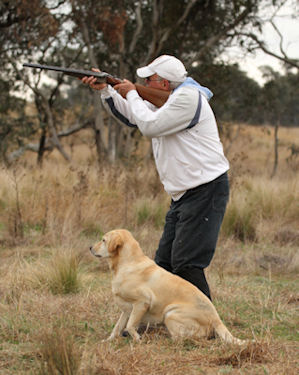The Double Rise
Retrieve
By Joe Law
28 January 2011
All
the tests that are set in Retrieving Ability Trials (RATG) and
Retrieving Trials (RT) are based on situations that would occur while
hunting. Retrievers, unlike
some other breeds of Gundogs, were
not originally bred to work in front of the gun but were specialists in
working off lead at heel with the hunter and only retrieving game after
it had fallen and then only when sent. Retrievers were
particularly important and of great value when game fell in areas that
were not easily accessible to the hunter such as in heavy cover and
swampy wetlands.
Furthermore, as most
game birds exist in
flocks, hunting opportunities will often result in more than just one
bird falling to ground. In these situations it is difficult
and
often impossible for the dog to simultaneously mark the fall of more
than one bird meaning that after one bird is retrieved, the dog needs
to be trained to return to the area of the original fall and continue
to search for other game that may have fallen in the same general
area. This is a different test to the Double Mark where birds
fall in different and well-separated areas and the dog has had time to
accurately mark and remember the two separate falls.
The Double Rise test
is described in the Retrieving Trial rules as follows:
Retrievers, unlike
some other breeds of Gundogs, were
not originally bred to work in front of the gun but were specialists in
working off lead at heel with the hunter and only retrieving game after
it had fallen and then only when sent. Retrievers were
particularly important and of great value when game fell in areas that
were not easily accessible to the hunter such as in heavy cover and
swampy wetlands.
Furthermore, as most
game birds exist in
flocks, hunting opportunities will often result in more than just one
bird falling to ground. In these situations it is difficult
and
often impossible for the dog to simultaneously mark the fall of more
than one bird meaning that after one bird is retrieved, the dog needs
to be trained to return to the area of the original fall and continue
to search for other game that may have fallen in the same general
area. This is a different test to the Double Mark where birds
fall in different and well-separated areas and the dog has had time to
accurately mark and remember the two separate falls.
The Double Rise test
is described in the Retrieving Trial rules as follows:
A
Double Rise Retrieve shall consist of a retrieve where one item of game
is cast as for a Mark Retrieve at which two shots are fired in
succession and before the dog is sent to retrieve. While the dog is
returning with the first item of game, a second item of game is cast or
placed no further than ten (10) metres from the fall of the first item
of game, but at a greater distance from the Firing Point. The second
item of game shall be retrieved immediately after the first item of
game is delivered to hand. On the second leg, a handler may cue the dog
using hand and voice to return to the area of fall of the first item of
game. Having sent the dog for the second item of game, the retrieve
should not be treated as a Blind Find Retrieve.
In Retrieving
Ability Tests the rule is fundamentally the same although no gun is
carried and shots are not fired.
On
the second leg of the Double Rise test, it is important for the handler
to have developed and trained the dog to respond to a distinct set of
cues for this test. Dogs can be trained to respond to both
visual
and verbal cues but in most cases, dogs understand visual cues more
easily than verbal cues. A good trainer pays great attention
to
the body language used and supplements this with distinct verbal
cues. Once the dog understands the nature of this test, it
will
immediately return to the area from which it has retrieved the first
article of game and will continue to search for another using both its
nose and eyes. It is not desirable for the handler to use any
further commands or signals once the dog is sent for the second
retrieve as, theoretically, even the handler is not exactly sure where
the fall lies and it is the dog’s natural game-finding ability that is
now being tested.
As in all retrieving
tests the dog will be
judged from the moment the lead is removed from the dog and will
conclude only when the handler with game in hand or bag has returned to
the starting point.
This is an edited
version of an article that first appeared in Dogs
NSW magazine, October 2012.
©
This
page is provided by Working Gundog Club Inc.
(Affiliated with Dogs NSW)

